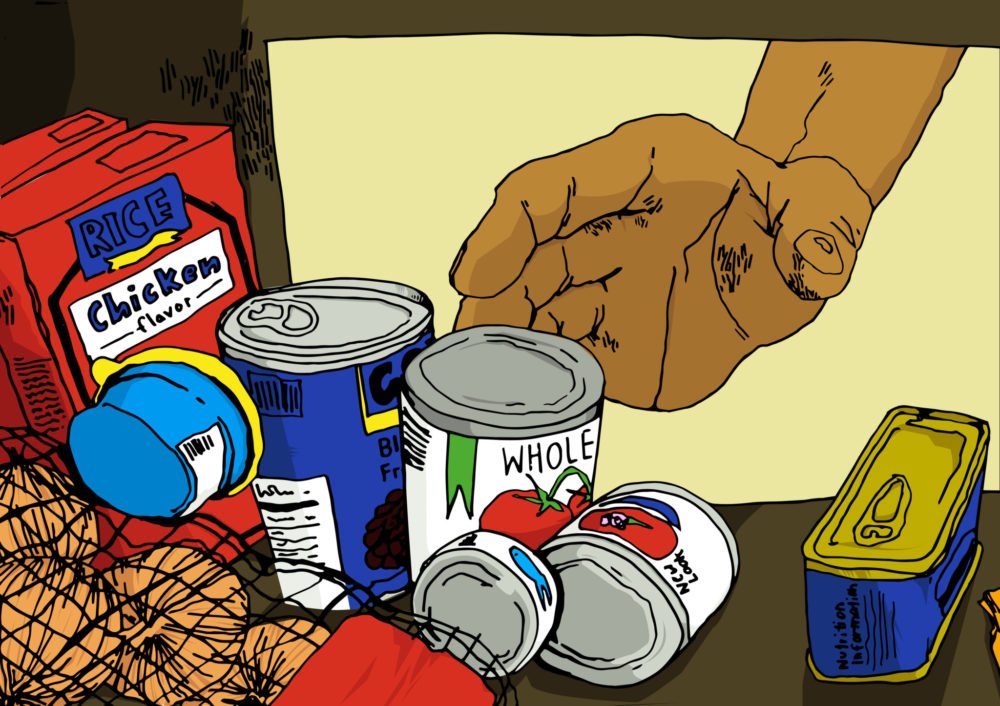
Food Access and Redlining in Boston
An evaluation of neighborhood redlining in Boston and its continued impact on food access today.
Introduction

(Courtesy of City Bureau, 2022)
Access to healthy, nutritious food is a basic human right, yet it is not a given for all Boston residents. In the City of Boston, food insecurity, or the inability to access adequate, nutritious food is a public health crisis.
The average rate of food insecurity in Boston hovers around 15%; However, this rate varies significantly based on demographic variables such as race and ethnicity, socioeconomic status (SES), poverty, employment status and geographic location. 1
Low-income communities of color in Boston experience some of the highest rates of food insecurity at more than 20% of residents. Additionally, Boston residents who are unemployed are more than twice as likely to experience food insecurity. Residents with a first language other than English are more than twice as likely to be food insecure. Furthermore, residents who were born outside of the U.S. are more likely to experience food insecurity. 1
There is an underlying issue of decades of systemic racism and racially-based discriminatory practices, such as redlining, in Boston. Research has associated redlining to major gaps and inequities in food access, as well as increased disparities in food insecurity among communities of color. 2 Yet, this discriminatory practice remains largely unexamined in the City of Boston.
Why This Topic?
Racism and discrimination are enormous barriers to health equity in the City of Boston, which is one of the reasons I chose this study area. In February 2023, Mayor Wu and the City of Boston announced the Task Force on Reparations , which will study the lasting impact of slavery in Boston. One of their main objectives is to identify the role that Boston played in supporting the institution of slavery, as well as forms of discrimination and racism, to improve racial equity and social justice in the city.
Although slavery was abolished in 1866, incidence of racial discrimination prevailed in U.S. systems and policies 3 . The 1930s practice of redlining was essentially government-sponsored segregation rooted in racism 3 and Boston historically had some of the most redlined areas in the country 4 . In order to fully understand the impact of slavery on present-day Boston, redlining must be examined on a deeper level.
Throughout the last few years, there has been research on how racialized urban processes, such as redlining, continue to impact communities. Strong connections have been made that link redlining and lack of access to fresh food. Research shows that neighborhoods that received HOLC grades of C and D have less access to affordable, healthy food and higher rates of food insecurity and food assistance use 2 .
Project Objective
The main goal of this Story Map is to examine the racially-based discriminatory practice of redlining and show its continued impact on Boston neighborhoods through mapping of food insecurity rates and specific demographic variables in areas that were historically redlined.
Additionally, I hope to showcase the inequity that still exists in Boston due to redlining, and outline where there are still gaps in food access based on the place an individual lives. This will lead to increased awareness and possible policy recommendations.
HOLC Residential Security Map of the Greater Boston Area (Courtesy of Boston Political Review, 2021)
A Brief History of Redlining
In the 1930s, the Home Owners' Loan Corporation (HOLC) graded over 200 U.S. metropolitan cities to determine their level of mortgage security. Each neighborhood in a city was given a grade of A, B, C, or D, which corresponded to certain level of risk. These grades were then displayed via color-coded residential security maps to demonstrate the level of security for banks and various mortgage lenders 5 .
What is Redlining? (A video by PBS)
Color-Coded HOLC Grades:
- Green: Grade A, or "Best"; indicated minimal risk for lenders. These grades were always assigned to wealthy, upper or middle-class, white neighborhoods.
- Blue: Grade B, or "Still Desirable"; indicated low risk and an adequate investment. These grades were generally assigned to neighborhoods comprised of residents who were generally white, native to the U.S., and white-collar families.
- Yellow: Grade C, or "Declining"; denoted that the desirability of the area was declining. These grades were given to areas where residents were part of the working-class and/or not completely white. Many of these neighborhoods were also inhabited by immigrants.
- Red: Grade D, or "Hazardous"; represented the highest risk to potential lenders. Grades of D meant that the neighborhoods contained populations, riddled with dangerous influences. However, this really meant that the neighborhoods were primarily non-white, communities of color, with racially and ethnically diverse backgrounds.
Data
Data Sources
- City of Boston Boundary (Esri GeoInquiries 2020)
- U.S. Census Block Groups (2020)
- Home Owners' Loan Corporation (HOLC) Redlining from Esri (2020)
- Food Insecurity Rate by Census Tracts (Greater Boston Food Bank Data 2022)
- Socioeconomic Status (NSES Index) by Census Tract, 2011-2015 ACS
- U.S. Grocery Stores (Esri Business Analyst 2020 Data)
- ArcGIS Esri geo-enriched data
Methods
To clearly show my selected study area, I first used the City of Boston Boundary layer. I also knew that I wanted to use census block groups as my unit of analysis, so I added a layer of U.S. Block Groups, and used the clipping tool to identify block groups within the same census tract in the City of Boston only.
Cartographic Flowchart of Boston Block Groups
To create the Boston Redlining map, I used the Home Owners' Loan Corporation (HOLC) Redlining Layer from Esri. This layer included redlining grades for over 140 cities in the U.S., but I clipped it to my already existing my City of Boston layer. Additionally, I changed the basemap to 'Light Gray Canvas' so that the colors of the HOLC grades would really pop.
Cartographic Flowchart of Boston Redlining
Using this same methodology, I mapped current food insecurity rates within the City of Boston so I could see how current rates overlap with redlining grades. I found data from the Greater Boston Food Bank that showed food insecurity rates in the Greater Boston Area, and then I clipped this layer to my City of Boston Layer.
After I created this map, I set out to create maps for each of the demographic variables I wanted to look at which included: race and ethnicity, socioeconomic status, poverty, and food assistance (SNAP). In order to complete this process, I used geo-enrichment via ArcGIS Pro to add these variables within my City of Boston Boundary. Then, I mapped food access by doing a service area of Boston grocery stores that were within 0.5 miles walking distance in each block group
Cartographic Flowchart of Enriched Boston Block Groups
Lastly, I wanted to see how redlined areas experience food access today. In order to map food access, I created a service area analysis of grocery stores in Boston. I used a 0.5 mi walking distance to see which areas in the city had the most food accessibility.
Cartographic Flowchart of Food Access Service Area
Results
The racist and discriminatory process of redlining in the 1930s has contributed to inequity and gaps among Boston neighborhoods today. Historically, areas that were redlined due to their diverse make-up and lower income, now see the highest prevalence of food insecurity, poverty, food assistance, and and more diversity. These areas also lower SES than areas that were not redlined and are predominantly white.
Food Insecurity
Relationship of Redlining and Food Insecurity Rate
Maps of Boston HOLC Grades (Left) and Food Insecurity Rates (Right)
In the map above, the overlap of redlined neighborhoods and food insecurity rates is clearly shown. This coincides with research that identifies redlining is associated with higher prevalence of food insecurity in low-income, racially and ethnically diverse communities 3 .
By mapping food insecurity in Boston and understanding where it is most prevalent, we can then look at the demographic variables of that area and how outcomes change based on geographic location.
Demographic Variables
Race and Ethnicity
Map of Boston Race and Ethnicity (Diversity Index)
Poverty
Map of Boston Poverty
Socioeconomic Status (SES)
Map of Boston Neighborhood Socioeconomic Status (NSES)
Food Assistance (SNAP)
Map of Boston Food Assistance Use
Food Access
Boston Grocery Stores
Boston Food Access Service Area
Conclusion
Each map portrays that the neighborhoods of Boston which were historically redlined, are some of the same areas that have now have higher rates of food insecurity, higher prevalence of poverty/low-income, more food assistance (SNAP) use, and are more racially/ethnically diverse.
They are also the same areas where there is lower SES, which in this case takes into account measures of median household income, percent of individuals with income below the federal poverty line, educational attainment of adults, unemployment rate, and percent of households with children under the age of 18 that are "female-headed" (no male present).
Although the service area does specifically associate redlining with reduced or lower food access, it is still crucial to point out that these racially and ethnically diverse neighborhoods still experience the highest rates of food assistance, poverty, low-income, and unemployment. With this being said, although there may be adequate food access, redlining and other discriminatory practices which have led to economic instability and inequity among communities of color may impact their ability to afford fresh, healthy foods. However, Based on these maps and the data presented, it is concluded that redlining still impacts Boston residents today and there must be justice for this legacy of racism evident today.
Next Steps
As we know, this was an 11-week course which is not nearly enough time to complete everything I would have liked to! Next steps I would take include geo-enriching my mom socioeconomic status (SES) rather than using the ACS 2014 data. I would also like to create a service area of perhaps 1 to 2 miles walking distance to grocery stores.
In addition to, I would map food pantries, community gardens, and farmers markets. Urban farming has also increasingly been on food access policy agendas of Boston activists, health collaboratives, and policymakers. I would see if I could find data on where (if any) are there plots of land for urban farming in Boston to examine which populations would have most access to them.
Lastly, I did not have a chance to map transportation routes in relation to grocery stores. I'd be interested to see on a map where the stores are in relation to public transportation routes, as many Boston residents do not own cars, especially those living in historically redlined areas.
References
- Mayor's Office of Food Access. 2021. "Mayor's Food Access Agenda 2021-2023." https://www.boston.gov/sites/default/files/file/2021/04/Mayor%27s%20Food%20Access%20Agenda%202021-2023.pdf
- Shaker, Yasamin, Sara E. Grineski, Timothy W. Collins, and Aaron B. Flores. 2022. “Redlining, Racism and Food Access in US Urban Cores.” Agriculture and Human Values, July. https://doi.org/10.1007/s10460-022-10340-3 .
- Rothstein, Richard. 2018. "The Color of Law: A Forgotten History of How Our Government Segregated America." New York: Liveright Publishing.
- Stermon, Mallory, and Chris Lukinbeal. 2021. “Institutionalized Racism: Redlined Districts Then and Now in Boston, Detroit, and Los Angeles.” Yearbook of the Association of Pacific Coast Geographers 83 (1): 81–97. https://doi.org/10.1353/pcg.2021.0007 .
- Ofulue, Camille. 2021. "Redlining in Boston: How the Architects of the Past Have Shaped Boston’s Future." https://www.bostonpoliticalreview.org/post/redlining-in-boston-how-the-architects-of-the-past-have-shaped-boston-s-future